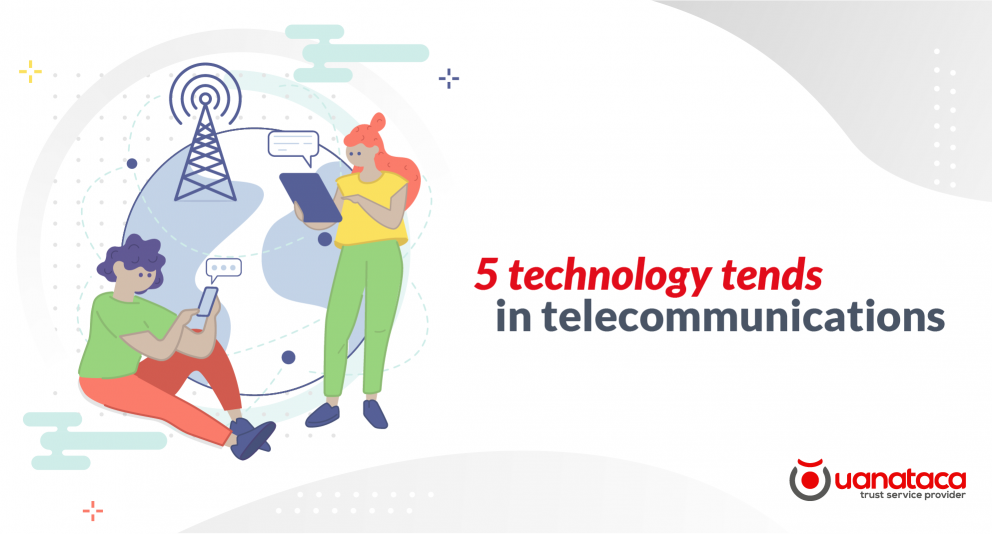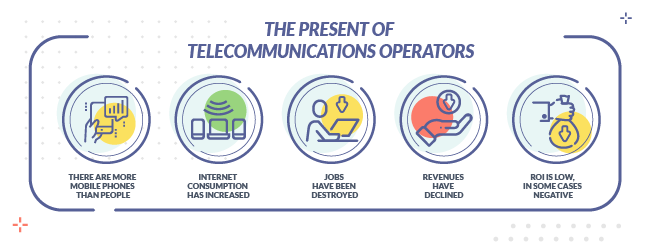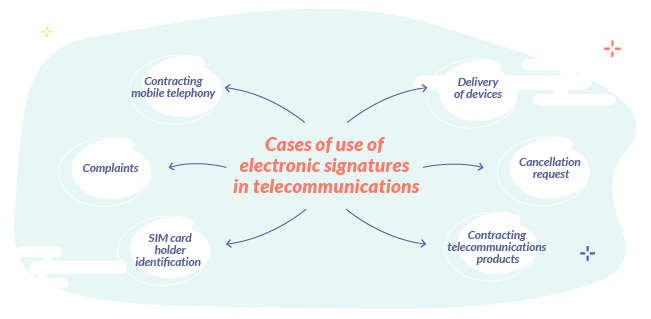
The global pandemic has turned the advances of some emerging technologies such as IoT or SD WAN into essential infrastructures for the operation of telcos and all the industries around them. In this context of transformation, technology plays an essential role in defining more efficient and less disruptive processes.
In this article you will find a compilation of the technological trends in telecommunications for 2022, a year that holds great opportunities for the industry.
Remaining challenges in the telecommunications sector
In some parts of the world there are already more cell phones than people. Humanity has reached record numbers and, in most developed countries, the total number of active cell phones is greater than their population. Parallel to this trend, the use of Internet lines at home has also increased, reaching 60% more Internet lines at home in countries such as Spain than 10 years ago.
However, despite the increase in consumption of services, the sector's performance in economic terms has been negative in some countries. In Spain, 35% of income has been lost in the last ten years, 25% of employment and returns on investment are not very high, in some cases even negative.

In the reorientation of the industry, telecommunication operators have to digitally transform themselves to be much faster and more flexible. If they want to return to previous levels, they need to define processes that are more efficient, more agile and create fewer problems. To achieve this, they must integrate technology into their processes. This will simplify their organizational structures, processes and systems. Internally, they must exploit intelligence and data to become more effective and efficient. Externally, it is vital to offer customers innovative experiences and even develop new businesses that make a big impact.
5 technology trends that will drive telco innovation
1. 5G communication
Today we are already talking about the fifth generation of mobile networks. This new generation is a far cry from the first, whose main application was exclusively voice.
The first of the changes of this fifth generation will be the way of accessing the network and the advantages brought by the WWWW (World Wide Wireless Web). The WWWW is designed for a mobile ecosystem where consumers will get seamless broadband connectivity, a rich ecosystem of mobile applications and cloud-based services.
5G technology also promises data transmission speeds of up to 10 Gbps, which means that the speed will be 100 times faster than 4G.
The new 5G communication opens up new perspectives and a promising future. The fifth generation of mobile telephony comes with great and important commercial opportunities for the telecommunications industry. Its practical applications extend to services such as transportation, medicine, agriculture, public services, among others.
2. WiFi 6
The WiFi organization (Wireless Fidelity) has already launched the standard known as 802.11 ax, with the commercial name of WiFi 6.
One of its main advantages is the greater capacity to serve devices, lower energy consumption and higher speed for obtaining information, which means that a single access point of action 6 is capable of serving up to 500 devices at the same time.
Like 5G, WiFi 6 technology also has practical applications in the field of entertainment, such as augmented reality or virtual reality. But it also has other uses in industry or sectors such as medicine: telemedicine, teleworking, IoT and Smart City, which we will discuss in the next point.
3. SMART CITIES
Smart Cities are becoming more and more numerous in the world. Cities such as Tokyo, New York, Singapore or Barcelona are at the forefront of the different fields of action linked to a Smart City. For example: the environment, urban mobility, security, education, health, economy and government.
In reality, smart cities go beyond the use of technology to connect the city. It is about harnessing the potential of innovation to solve the challenges of living in cities, with the goal of benefiting citizens. In order for cities to continue to grow, it is necessary to adopt technologies such as 5G, WiFi 6 and others.
In general, smart city solutions can speed up emergency responses, reduce travel time or cut greenhouse gas emissions.
4. EDGE COMPUTING
Edge computing is one of the technologies that will define and revolutionize the way humans and devices connect to the Internet. The rise of IoT devices is producing an enormous amount of data to be computed in data centers, pushing network bandwidth requirements to the limit.
The goal of edge computing is to bring computing and data storage closer to the location where it is needed to improve response times and save bandwidth.
5. ELECTRONIC SIGNATURE
In the telecommunications sector, with the highest customer churn rate in the market, the signing of documents is constant. During its life cycle, the customer must sign all types of documentation associated with the registration, such as the adhesion of services or the receipt of a SIM card. Similarly, to formalize the cancellation, it is also necessary to sign the cancellation request and other related documents.
To streamline these procedures and avoid problems with customers, telecommunications operators must implement tools that enable them to maintain a dynamic and fluid relationship with their customers.
Integrating e-signature solutions helps to speed up the connection with customers: digital, agile and paperless onboarding processes make this procedure an added value for the customer. In turn, the digitization of signature processes increases the efficiency and productivity of internal business processes.

In the year 2022, electronic signature through video-identification will become one of the most demanded innovative technologies in the telecommunications sector. In countries such as Spain, remote identification has already been regulated as a valid method and guarantor. Its use will provide electronic signature processes with the immediacy and accessibility demanded by the new digital customer.
⭐️⭐️⭐️⭐️⭐️⭐️ Our recommendation for Telecom operators: One-Shot Signature
Uanataca offers services tailored to telecommunications operators, enabling the implementation of electronic signatures in processes of signing contracts of discharges and generation of electronic evidences.
One-Shot Signature is Uanataca's exclusive solution designed to facilitate the interaction with the digital customer: your customers will be able to sign documents with a digital certificate without the need to have one already. Ease and immediacy to offer the best digital experience.
Without subscriptions, easy to integrate and with the maximum guarantees of Uanataca, Qualified Service Provider of trust.
